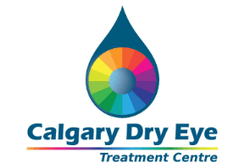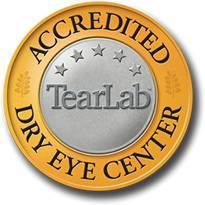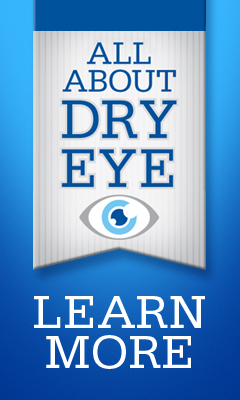Dry eye occurs when your body cannot produce an adequate amount of tears to keep your eyes moist, clear and comfortable. As many as 20 million Americans suffer from some degree of dry eye syndrome. Women are 3 times more likely than men to be affected.
Mild to moderate dry eye is most frequently associated with aging (particularly peri or postmenopausal women), contact lens wear, and computer use. Moderate to severe dry eye is often associated with Sjogren’s syndromeand LASIK vision correction surgery.
The Most Common Causes
Some causes or situations that increase the risk of dry eyes include:
- A bodily change such as aging, arthritis, contact lens usage, pregnancy or menopause or abnormalities of the eyelids.
- Certain medications which are are known to increase susceptibility to the condition. including medicines prescribed for acne, allergies and sinus problems.
- LASIK or vision correction surgery..
- Exposure to sun, wind, smog, air conditioners, ceiling fans, forced heat and hair dryers.
- Contact lens wear or frequent work with computers.
- Learn about getting a diagnosis.
Aging
Aging is directly associated with a reduction in lipid production, resulting in evaporative dry eye.
Climate and Environmental Factors
Outdoors and indoors, humidity levels, wind, and presence of irritants can contribute to dry eye symptoms:
- Hot, dry and/or windy climates
- High altitudes
- Excessive sun exposure
- Central heating
- Air conditioning
- Hair dryers
- Cigarette smoke
- Air pollution
- Air travel
Contact Lens Wear
Dry eye is the most common complaint amongst contact lens wearers. Contact lenses absorb the tear film, and rub against the conjunctiva in the eyelids, which may cause or exacerbate dry eye. Long-term contact lens wear may decrease epithelial nerve sensation, which would reduce the stimulus to produce more tears.
Diseases
- Parkinson’s disease
- Sjogren’s syndrome (an auto-immune disease with
- Auto-immune diseases (lupus, rheumatoid arthritis, Sjogren’s)
- Rheumatoid arthritis
- Lupus
- Lacrimal gland deficiency
- Diabetes
- Sarcoidosis
- Stevens-Johnson syndrome
- Rosacea: Facial rosacea is commonly associated with ocular rosacea, which causes conditions such as blepharitis
Eye Injuries/Surgeries
- Chemical burns
- Laser refractive surgery, e.g. LASIK, PRK, LASEK, epi LASIK, etc. LASIK is best known for dry eye because it severs or ablates more nerves than any other refractive surgery.
- Corneal transplants
Eyelid Conditions or Anatomical Features
- Lagophthalmos: Incomplete closure of the lids (may be natural, may be caused by hypothyroidism, LASIK, blepharoplasty, or other factors)
- Droopy eyelid
- Bulging eye
- Proptosis
- Ectropion
- Entropion
- Nocturnal lagophthalmos
- Bell’s palsy
- Pterygium/Pingecula
- Conjunctivalchalsis
Eye Diseases Affecting the Meibomian Glands
- Blepharitis
- Ocular rosacea (thought to be present in up to 75% of perimenopausal women with facial rosacea)
- Meibomian gland dysfunction (also called meibomitis or meibomianitis)
Hormonal Deficiencies/Changes
- Thyroid conditions
- Hormonal changes during menopause
- Decreased production of androgen
- Estrogen supplementation (there are reports both of this improving dry eye conditions and worsening them!)
Low Blink Rate
Blinking is a critical function in spreading tears over the eye surfaces and stimulating tear production. A chronic low blink rate is associated with dry eye symptoms.
Whenever focus on an object near at hand on a sustained basis, you are probably blinking much less frequently. Computer use, reading, and watching TV are the three activities most commonly associated with a low blink rate. Computer use is believed to reduce the blink rate from 22 per minute to 7 per minute.
Medications
Many medications can cause or exacerbate dry eye symptoms. If a medication you are using seems to be making your eyes worse, read up on side effects and discuss options with your doctor – s/he may be able to prescribe an alternative medication with a better side effect profile. Use common sense though – don’t stop taking a medication without consulting your doctor!
- Allergy medications, esp. antihistamines
- Antidepressants (e.g. amitriptyline, diazepam)
- Some blood pressure medications
- Parkinson’s medications
- Birth control pills
- Diuretics
- Beta blockers
- Sleeping pills
- Many pain medications
- Certain medications which regulate heart rhythm irregularities
- Decongestants
Other
- Radiation therapy
- Smoking
- Vitamin A deficiency
Thanks to The Dry Eye Center for content used in the creation of this webpage. ©2011 – All rights reserved. Reproduction other than for one-time personal use is strictly prohibited.



